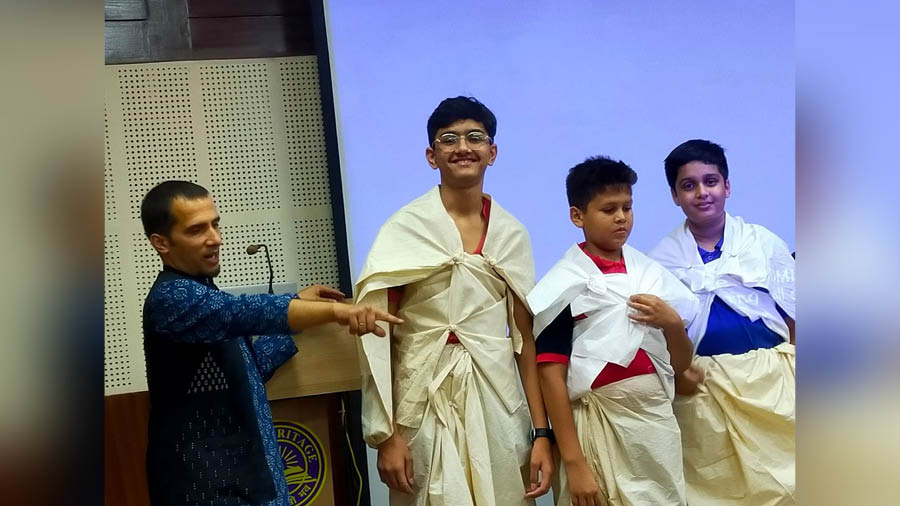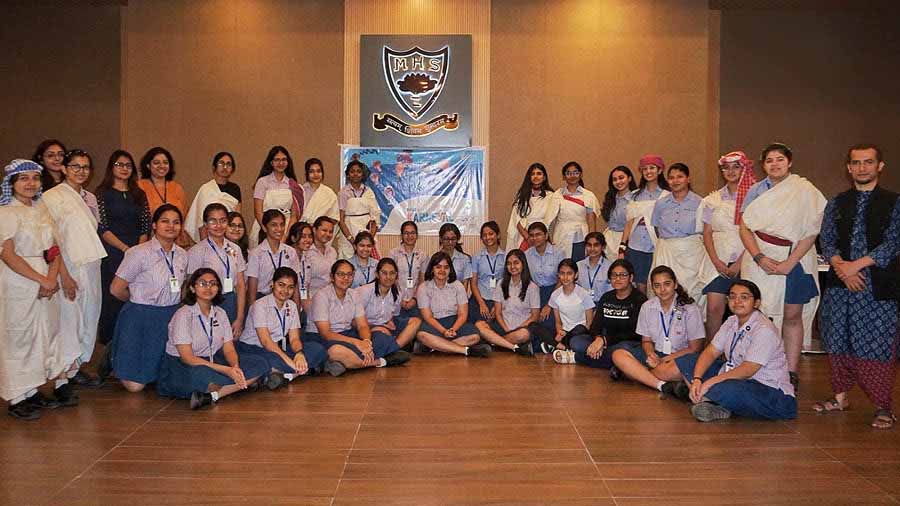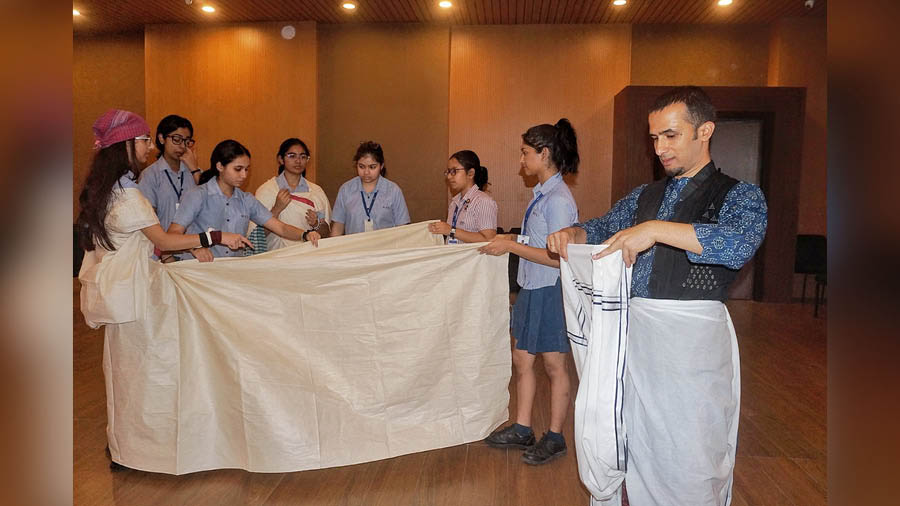Be fashionable but be kind to the environment as well, this was the message for students who attended the session on Sustainable Drape Culture as part of Pasch Karneval organised by the Goethe Institut- Max Mueller Bhavan.
TEDX speaker, education designer and former host of Walt Disney’s Art Attack, Gaurav Juyal, conducted workshops at Modern High School International and The Heritage School, Kolkata, on April 11. The sessions were part of the Schools: Partners for the Future (Pasch) programme that ties global schools to Germany and initiates among students the love and knowledge of German society and language. The three-day Karneval brought together diverse minds from fields of STEM, art, culture, sustainability, mental health and more.

TEDX speaker, education designer and former host of Walt Disney’s Art Attack, Gaurav Juyal, conducted workshops at Modern High School International and The Heritage School, Kolkata Heritage Goethe Institut
Around 40 students from Classes IX to XII took part in the workshop at Modern High and around 70 students from Classes VI, VII and VIII attended the session at The Heritage School.
My Kolkata attended the session at Modern High School International and here’s what we learnt.
About draping and sustainability
Juyal spoke about how fast fashion is destroying the climate and how repurposing, reusing and a touch of creativity can go a long way in creating a beautiful world.
“Apart from how it looks, draping has an environmental significance. Fast fashion is one of the largest polluters today. People love fashion, but it’s important for them to realise what it costs us and the planet. Draping is a great option because it does not involve a lot of processes like chemical treatment, cutting or sewing; it is good for the environment because the carbon footprint is low,” Juyal said. “Draping also allows a lot of experimentation which is great for young minds. We want to get the youth involved in draping again.”
Juyal began the two-hour workshop with the definition and history of drape culture, fast fashion and its adverse effects on the environment. Next, he introduced the Button Masala technique of draping inspired by designer Anuj Sharma. He then moved on to the more practical, fun and experimental part of the workshop where participants used the Button Masala technique to come up with three kinds of drapes — headgear, upper garment and dhoti. Once they got the hang of the technique, there was no end to their creativity.
“Sustainability is something that can be done over and over for an endless number of years and it does not create an imbalance. We have to basically find our limits. Going limitless is bad for the environment. Another way to practise sustainability is through Repair Culture. Old clothes, materials can be recycled. Again, it adds much value to your intelligence if you can learn how to mend things.”

Students from Modern High School attended the session Soumyajit Dey/My Kolkata
Button Masala Technique
Fret not if you don’t have sui-dhaga (needle and thread) or safety pins at hand, all you need is a button and a rubber band. Place the two cloth points that you want to join on top of the other, place the button on one side and tie it with a rubber band and voila… your cloth pieces are joined! This Button Masala Technique was initiated by designer Anuj Sharma and formed the basic principle of the workshop.
Headgear

Headgear Soumyajit Dey/My Kolkata
Remember Brenden Fraser in The Mummy strolling about in the desert in search of pyramids? Now you can get the look with this easy-to-follow drape technique mostly seen in West Asian countries or arid regions.
The easiest form of drape requires a fairly large squarish cloth of any colour. All that is needed is to tightly cover the head with one side and lock the two ends with the Button Masala Technique. After locking the ends, one would be left with the tail on two sides. One tail can be twisted and wound around the head, while the other tail, left as it is, can be draped over the face to form a mask.
Kamakshi Biswas Mazumdar, a Class X student of Modern High School for Girls, shared her experience post the workshop. “I felt very involved with my other teammates and we were working on just one piece of clothing, draping it around her body and playing around with the drapes. Fashion is so much more than just sewing and cutting. I loved creating the upper garment. It’s also intriguing how we are so ignorant about the fashion industry and buy clothes as per trends but don’t stop to think how it’s harming the environment. Today, I learnt about reusing. Instead of buying 10 different tops, I can fashion 10 different tops out of one fabric.”

Upper Garment Heritage Goethe Institut
Upper Garment
Top, jacket, dress… drape and make it whatever you want with the sustainable technique. The upper garment was made with one cloth of fabric draped around the body and locked at various junctures with the Button Masala Technique. For tops and jackets, one required a smaller cloth length but for dresses one easily combined two cloth pieces with the technique to get their desired length. The participants went a step ahead and started choosing colourful fabric to create designs and innovation. While a student had a belt with a cloth flower attached, another draped a bodice in a contrast colour to make the garment look different and a third one made it into a dress with functional pockets. After they finished draping, they could challenge ‘Friends, Romans, Countrymen’ with their fashion creativity.
“I enjoyed the workshop as I am inclined towards crafts. I have used the Button Masala Technique before, especially when I am wearing something loose and don’t have stitching material on me at that moment. My two learnings will be repurposing a lot of things and finding the interconnectivity of fashion with environment and history,” said Sanjana C. Mittra, a Class XI student from Modern High School International said.

Draping a dhoti Soumyajit Dey/My Kolkata
Dhotis
What was considered to be traditional menswear for a long time is slowly becoming a comfortable drape for everyone. Juyal demonstrated how to wear a dhoti and even gave tips for securing it tightly. All you need to do is have a cloth piece at least four metres in length, find the midpoint of the cloth and stand in front of it, tie the two ends securely to a double knot at your waist, pleat the two remaining ends, take it from under your feet and tuck it backwards. That’s just how simple wearing a dhoti is. What made this simple technique interesting was when participants started illustrating the dhoti or trying out different forms of drapes, even trying to be Devdas at a point in time.
“We learnt about drape culture, fast fashion and how it impacts the environment. We even got to make our own Dhotis and tops with drapes,” said Kabir Mukherjee, a Class VIII student from The Heritage School.
Juyal signed off by saying, “Fashion designers sometimes use draping as a step to create the final garment but I think draping itself can become the final garment. In fact, the students today have taken the liberty of adding their own minds and that’s what I intended to do. I’m glad that it shows in one session.”
